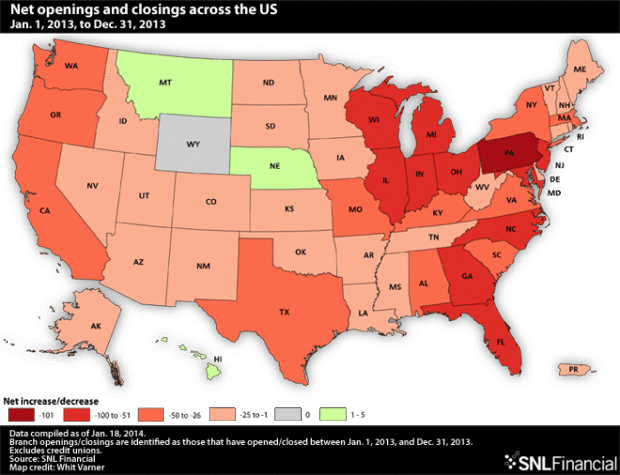In The Myth of Branch Decline, published in TheFinancialBrand.com, the author states:
“Reversing three years of declines, the number of bank branches in the United States increased by more than 250 units in the 2013 FDIC reporting year. Banks opened almost 3,000 branches during the past year, the highest level since 2009. Those opens were offset by more than 2,700 branch closures, a substantial level but still lower than the 3,100 closures of the preceding year.”
SNL reported, however, that “banks slash branch totals in 2013.” According to SNL, the net number of closings was 1,487 (based on 1,076 branches opened, and 2,563 branches closed).
This webinar from Veeam will detail the value of working together across your organization to be better prepared in cyber defense and response readiness. Read More about How Banks Are Fortifying Their Data Against Increasing Cyber Threats Connect with your customers and provide lightning-fast support as effortlessly as texting friends. Two-way SMS text messaging is no longer optional.

How Banks Are Fortifying Their Data Against Increasing Cyber Threats

Instant Messaging. Instant Impact.
My take: Somebody’s not right, and it doesn’t really matter because no one is asking the right questions.
I don’t know who’s right and who’s wrong here. The FB article author cites the FDIC as his data source, and that’s a pretty credible source. On the other hand, SNL is pretty credible, too.
But the most important question to answer here is not “whose numbers are right?”
At the heart of this debate about the number of branches is the question: Is the bank branch necessary? The problem with the debate is that the number of branches that exist in the US–and the net (or absolute) number of openings and closings–is not a good answer to the question.
A good answer would come from the answer to the question: What impact do branch openings and closings have on revenue growth and overall bank profitability?
The author of the FB article wrote:
“The branch remains the predominant channel for account opening, which of course is the primary objective of the facility, as well as an essential means of reinforcing the institution’s convenience and availability.”
Technically, the author is correct, the branch does remain the predominant channel for account opening. I would argue that part of the reason for that is that, at many banks, opening accounts online is an inferior experience. Not that it has to be.

But, That’s Not All
But the questions that no one is addressing are:
1. Does opening bank branches generate incremental demand for account applications?
2. Does closing bank branches reduce the demand for account applications?
3. What impact does closing bank branches have on customer retention?
If the bank you work for can close branches with no negative impact on new product demand and customer retention, then your bank should be closing branches as fast as you can.
If the bank you work for can generate incremental demand for accounts by opening branches, then your bank needs to do some difficult, but necessary, analysis to estimate how much that incremental demand will amount to over a certain period of time, and if the profitability from that estimated demand outweighs the cost of opening and staffing branches.
Trying to answer the question of the long-term viability of bank branches by looking at the number of openings and closings is a waste of time. And answering that question based on the number of account openings or consumer “preferences” isn’t the right approach either.
Maybe SNL can tell us what happens to overall product demand in regions with net openings and net closings.







